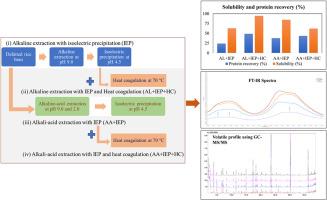Improving yield, functional properties, and aroma profile of rice bran protein through innovative extraction and precipitation methods
IF 3.7
2区 农林科学
Q2 FOOD SCIENCE & TECHNOLOGY
引用次数: 0
Abstract
Rice bran is a milling byproduct and rice bran protein (RBP) is a promising source of plant-based protein. This study investigated the impact of alkaline and acid extractions followed by isoelectric point (IEP) and heat coagulation precipitations on the quality and functionalities of RBP. Alkaline extraction, followed by IEP and heat coagulation, showed the highest protein recovery of 48.77%, which is double that of conventional alkaline extraction and IEP. The FTIR data showed that β-sheet and α-helix content reduced; however, random coil and β-turn increased by acid and heat addition. Addition of heat coagulation to IEP after alkaline extraction increased solubility from 62.94% to 94.74%. However, the emulsification and surface hydrophobicity were decreased during heat and acid-assisted extraction. The in-vitro digestibility was the highest at 83.57% in alkaline-acid extraction, followed by heat and IEP. The aroma profile of RBP shows a complex mixture of ethanol-2-butoxy, 2-methyl-4-vinyl-phenol, 2,4—heptagonal, (E,E)-, Undecane, and 5-methyl to form a typical flavor with waxy and rancid undernotes. The total amount of volatile compounds in conventional extraction was 1.97 μg/g, while alkaline-acid extraction with IEP had only 0.87 μg/g. The RBP from alkaline-acid extraction with IEP showed the least volatile compounds and most neutral proteins.

通过创新提取和沉淀方法提高米糠蛋白的产量、功能特性和香味特征
米糠是一种碾磨副产品,而米糠蛋白(RBP)是一种很有前景的植物性蛋白质来源。本研究调查了碱性提取和酸性提取以及等电点(IEP)和热凝沉淀对米糠蛋白质量和功能的影响。碱提取、等电点沉淀和热凝沉淀的蛋白质回收率最高,达到 48.77%,是传统碱提取和等电点沉淀的两倍。傅立叶变换红外光谱数据显示,加酸和加热处理后,β-片和α-螺旋含量减少,但无规线圈和β-匝含量增加。碱提取后的 IEP 加入热凝固后,溶解度从 62.94% 提高到 94.74%。然而,在加热和加酸提取过程中,乳化性和表面疏水性都有所下降。体外消化率最高的是碱-酸提取,达到 83.57%,其次是加热和 IEP。RBP 的香气特征显示出乙醇-2-丁氧基、2-甲基-4-乙烯基苯酚、2,4-庚基、(E,E)-、十一烷和 5-甲基的复杂混合物,形成了一种典型的蜡味和酸败味。传统萃取的挥发性化合物总量为 1.97 微克/克,而用 IEP 进行碱酸萃取的挥发性化合物总量仅为 0.87 微克/克。用 IEP 进行碱酸萃取的 RBP 显示出最少的挥发性化合物和最多的中性蛋白质。
本文章由计算机程序翻译,如有差异,请以英文原文为准。
求助全文
约1分钟内获得全文
求助全文
来源期刊

Journal of Cereal Science
工程技术-食品科技
CiteScore
7.80
自引率
2.60%
发文量
163
审稿时长
38 days
期刊介绍:
The Journal of Cereal Science was established in 1983 to provide an International forum for the publication of original research papers of high standing covering all aspects of cereal science related to the functional and nutritional quality of cereal grains (true cereals - members of the Poaceae family and starchy pseudocereals - members of the Amaranthaceae, Chenopodiaceae and Polygonaceae families) and their products, in relation to the cereals used. The journal also publishes concise and critical review articles appraising the status and future directions of specific areas of cereal science and short communications that present news of important advances in research. The journal aims at topicality and at providing comprehensive coverage of progress in the field.
 求助内容:
求助内容: 应助结果提醒方式:
应助结果提醒方式:


